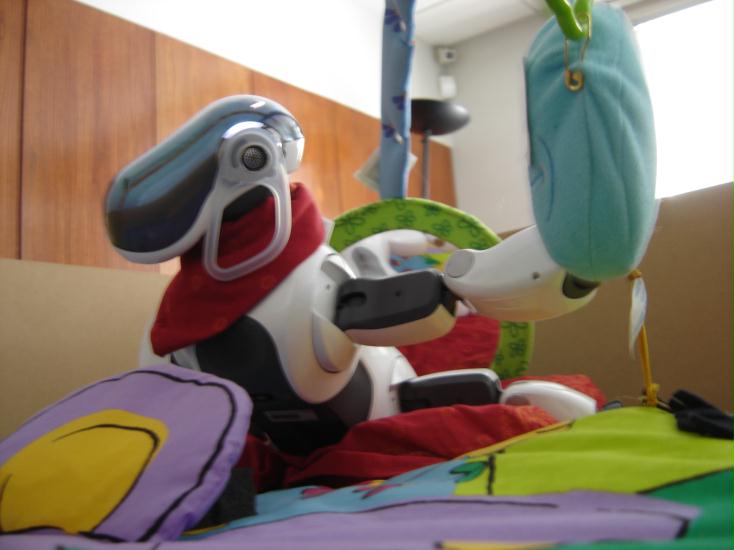Sony SCL - Playground Experiment

For the most impatient: the scientists have programmed the Aibo doggie so that it can explore the world on its own, i.e. without a given sequence of actions.
There are several videos here, where a robot, like a child, exploring the world around, link .
For those to whom it is not enough, welcome under habrakat.
So, in the last topic, someone lacked practice, so here it is, practice:
The structure of the robot
Judging by the instructions
the robot has 20 degrees of freedom
1.5 hours work,
consumes 9 watts
has temperature, infrared, distance, acceleration, pressure, vibration sensors,
32 megabytes main memory
and has a 64-bit RIS processor.
')
Staging experiment
As can be seen from this graph:

(on which, according to the developers, the robot performed about 15,000 actions)
the robot has only a few options (bite, hit, look around)several states from sensors (see nothing, see object 1 \ 2, successful bite / blow)
Steps indicated in the figure as P1-P5:
P1 - the robot learns to focus on certain objects and detect them.
P2 - an attempt to perform certain actions without applying them to any specific objects.
P3 - an attempt to move parts of your body, but without a specific goal.
P4 and P5 - more difficult actions, bite bite or kick a kick.
The most attentive probably noticed white sheets with a “marker” in the eye of a hanging toy and behind the ear of an elephant on the floor, in front of the dog. I did not find any mention of this in the experiment, but I can assume that it was used to simplify the identification of objects in the environment. Those. the dog did not define objects on its own; a certain algorithm did it for it. Anyway.
Inside view
The robot program consists of several modules.
* The first of which is the forecast module, each part of which is specialized in certain areas of the sensory-motor space.
* The second module is a metaprognosis system, the purpose of which is to predict its further development and the errors of the first module. It is based on what compares the error rate in the past and in the present.
* Third module - which selects an action based on the results issued by the second module.
It is assumed that the algorithm will allow you to choose actions that are not too predictable, but not too difficult to predict.
The purpose of the experiment
"It is a rule of thumb,” he said, “
The goal is to create mechanisms, realizing such phenomena as “curiosity”, which will allow you to create universal mechanisms with a minimum size of pre-programmed actions.
Those. Developers are eager to learn how to create self-learning machines that almost do not need human programming, which could be self-taught. Also, the developers say that they want to copy the behavior of young children, as they study the world around them, trying everything “to the tooth”.
Subjective view
In my opinion, this method (self-study) is quite a promising way to get more number of individual algorithms for specific tasks or just with different approaches. However, judging by the video, the developers gave the dog a very narrow circle of possibilities, in particular: a dog can hit a specific point in space only in a certain way and at a certain angle \ height, i.e. full body control is not. There is not even a self-made action, you can only change the movement parameters (point of impact), and make them in sequence. There is also no definition of objects, and much more, but even such a result is definitely interesting, because this is only the beginning.
Photos and materials

Lucky bite

Reversal kick
For those who are still small, here (1.2 mb, pdf, eng) is the description of the study that they call “Intellectual Adaptive Curiosity”. There are no source codes, but there are some formulas for calculating the program and a detailed description.
Issues for discussion
1) Does the prospect of learning robots as children, from the very beginning?
2) Is it possible to consider this experiment as meaningful if the robot was severely restricted in movement, and the definition of objects allegedly performed a separate algorithm?
3) Is it possible to consider this experiment successful, i.e. Did the robot really learn something new that was not originally incorporated into it?
Source: https://habr.com/ru/post/113610/
All Articles